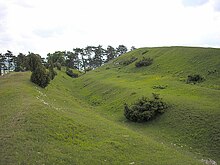Rampart (fortification)

In fortification architecture, a rampart is a length of embankment or wall forming part of the defensive boundary of a castle, hillfort, settlement or other fortified site. It is usually broad-topped and made of excavated earth and/or masonry.[1][2]
Types


The composition and design of ramparts varied from the simple mounds of earth and stone, known as dump ramparts, to more complex earth and timber defences (box ramparts and timberlaced ramparts), as well as ramparts with stone revetments.
Early fortifications
Many types of early fortification, from
Classical fortifications
During the
Medieval fortifications

After the
Elements of a rampart in a stone castle or town wall from the 11th to 15th centuries included:
- Parapet: a low wall on top of the rampart to shelter the defenders.
- Crenellation: rectangular gaps or indentations at intervals in the parapet, the gaps being called .
- Loophole or arrowslit: a narrow opening in a parapet or in the main body of the rampart, allowing defenders to shoot out without exposing themselves to the enemy.
- Chemin de ronde or wallwalk: a pathway along the top of the rampart but behind the parapet, which served as a fighting platform and a means of communication with other parts of the fortification.
- Machicolation: an overhanging projection supported by corbels, the floor of which was pierced with openings so that missiles and hot liquids could be thrown down on attackers.
- Brattice: a timber gallery built on top of the rampart and projecting forward from the parapet, to give the defenders a better field of fire.[4]
Artillery fortifications
In response to the introduction of
Elements of a rampart in an artillery fortification from the 16th to 19th centuries included:
- Exterior slope: the front face of the rampart, often faced with stone or brick.
- Interior slope: the back of the rampart on the inside of the fortification; sometimes retained with a masonry wall but usually a grassy slope.
- Parapet (or breastwork) which protected and concealed the defending soldiers.
- small arms.
- Barbette: a raised platform for one or more guns enabling them to fire over the parapet.
- Embrasure: an opening in the parapet for guns to fire through.
- Terreplein: the top surface or "fighting platform" of the rampart, behind the parapet.
- Traverse: an earthen embankment, the same height as the parapet, built across the terreplein to prevent it being swept by enfiladefire.
- Casemate: a vaulted chamber built inside the rampart for protected accommodation or storage, but sometimes pierced by an embrasure at the front for a gun to fire through.
- Bartizan (also guérite or echauguette): a small turret projecting from the parapet, intended to give a good view to a sentry while remaining protected.[7]
Archaeological significance
As well as the immediate archaeological significance of such ramparts in indicating the development of military tactics and technology, these sites often enclose areas of historical significance that point to the local conditions at the time the fortress was built.[2]
See also
References
- ISBN 978-0-7509-3994-2
- ^ ISBN 978-0-19-953404-3.
- ISBN 978-0-19-860678-9.
- ISBN 978-0-19-539536-5(pp. 299-300)
- ^ Hogg, pp. 28-31
- ^ Hogg, pp. 39-40
- ^ Hogg, pp. 55-58
